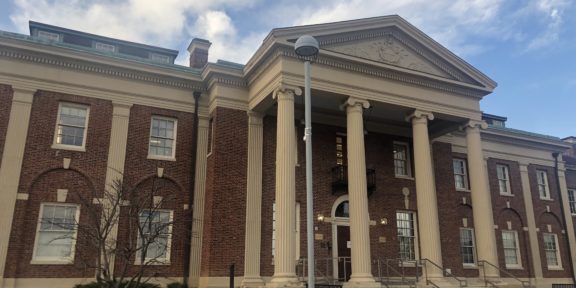The St. John’s Grand Lodge is an old community hall space with blue and white tiles and chairs scattered throughout the area. It was the home of the Advisory Neighborhood Commissions meeting for Ward 5B on Feb. 27, 2019.
Douglas Buchanan and Mike Donlan presented phase II of The Right Care, Right Now program, headed by the D.C Fire and EMS Department. The program aims to improve patients’ health outcome and preserve the D.C. Fire and EMS Department’s resources for patients with life-threatening injuries and illnesses.=
“What we’re hoping to do… is that this will allow our transport units to be more readily available for patients with life-threatening, serious or critical injuries. While also freeing up the beds in the emergency room,” Buchanan said during his presentation. “But, the bigger picture, the bigger pitch is that we’re trying to improve the health outcomes of district residents and all those that we serve.”
When faced with a patient calling 9-1-1 who is determined non-emergency, the patient will be referred to urgent care or a clinic. “We are not doing the patient or our department any favors by putting someone with a sore throat and a stubbed toe in the back of an ambulance and taking them to the emergency room,” Buchanan said.
Twenty-one clinics in the area are participating in the program.
D.C. launched Phase I of the program in April 2018. During the nine months of Phase I, D.C. FEMS referred 377 patients to clinics and 323 patients to self-care. Phase II of the pilot began on March 1, 2019. The second phase allows FEMS first responders to assess patients based on medical protocols before connecting to the nurse triage line.
“When they feel that that patient’s most appropriate or most responsible path to care is outside of the emergency room, they’re going to connect with a nurse inside the nurse triage line,” explained Buchanan.
Phase I did not include FEMS first responders assessing patients before they connect with the nurse triage line. Buchanan says during the first phase there was reluctance when determining a patient’s course of action which caused for a second phase. This addition allows for a more accurate response while still sustaining FEMS’ resources.
The program has partnered with Lyft to provide rides to and from the clinics for patients who are enrolled in any form of Medicaid or D.C. Healthcare Alliance. Those with other types of private insurance will be assessed and have to provide their own transportation. The ridesharing app gives same-day transportation to clients.
These aides patients because many without access to reliable transportation use 9-1-1 as a tool to get to appointments, Buchanan says. He adds that the time it takes to transport a patient to urgent care or clinic via Lyft is much less time than what it would be taking them to an emergency room. “What we have found is taking the patient via Lyft, being seen and returning can take about two to two and a half hours. When we transport them to the emergency room in an ambulance, it can take up to six hours.”
Mayor Muriel Bowser (D), whose office championed the program, directed questions about the second phase to D.C. Fire.
Vito Maggiolo, Public Information Officer at the DC Fire and EMS Department, said, “Right Care, Right Now is an ongoing initiative to provide the best patient outcome for all of the community that we serve throughout the District of Columbia.
“Often, a patient needs to not necessarily require transportation to a hospital emergency room. It is our effort to make sure that the patient aware of our options.”
During Buchanan and Donlan’s presentation Patrick Flynn, a District resident, asked, “How does this fit in with the people who call in who don’t have insurance?”
Buchanan answered, “We can make an appointment at one of the clinics, but we won’t be able to provide them transportation.”
When asked how they felt about the policy D.C. residents gave mixed responses. Zahraa Lopez responded, “I think it is a good way to free space in emergency rooms. Every time I have been in an emergency room, it has taken an unnecessarily long time.” A few other residents were concerned with what happens if a person is misdiagnosed or receives a wrong report.
Buchanan says D.C. FEMS hopes the policy will encourage better health care practices in the community. After visiting the urgent cares or clinics, patients can make a follow-up appointment and create a real relationship with a doctor in their community. He hopes that ultimately this incentive will have patients continuing to seek and receive treatment from doctors who know their medical history.
“We’re optimistic that if this works, it’s going to improve the health of all the patients that we treat.”






